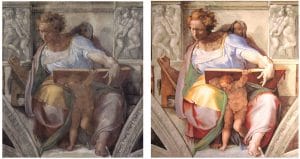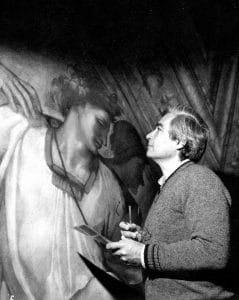Born in Rome, Colalucci graduated from Italy’s Istituto Centrale del Restauro (Central Institute for Restoration), where he studied under art historian Cesare Brandi. Colalucci restored artworks by Raphael, Giotto, Titian, and Buonamico Buffalmacco, among others. The “among others” is key: he is best known for just one job — “the restoration of the century”: Michelangelo’s paintings inside the Sistine Chapel in Vatican City. He had worked at the Vatican since 1960, and became Chief Restorer in 1979. It was a big job: not only in physical size, but the paintings covered by centuries of dirt and smoky wax (from candles), as well as previous restoration attempts to undo or fix, including layers of glue to help preserve the works, and even water damage from leaks. Work started in June 1980 with a hand-picked team.

The restoration wasn’t done simply according to Colalucci’s judgement: he and his team followed The Rules for Restoration of Works of Art, laid down in 1978 by Carlo Pietrangeli, Director of the Vatican’s Laboratory for the Restoration of Pictures. Every stage of the work was documented photographically. The ceiling work was unveiled in 1994; the work wasn’t fully completed until December 1999, when the wall frescoes were unveiled. As Pope John Paul II celebrated mass in the newly restored chapel on April 8, 1994, “I felt like I had been struck by a bolt of lightning,” Colalucci wrote later, “and suddenly understood two important things: the transcendent spirituality of Michelangelo’s paintings and the true meaning of working inside the Vatican.”

The difference was breathtaking. “This restoration,” said Cardinal Edmund Szoka, the governor of Vatican City at the time, “and the expertise of the restorers allows us to contemplate the paintings as if we had been given the chance of being present when they were first shown.” Not all were enthusiastic, however. “It’s like having a facelift,” complained American art historian James Beck, who tended to criticize restorations. “How many times can people go through one without their poor faces looking like an orange peel?” The Vatican defended the work. “We removed dirt,” Fabrizio Mancinelli, director of the Vatican Museums’ Department of Byzantine, Medieval and Renaissance Art said in 1990. “We didn’t remove Michelangelo.” Small areas were left unrestored to maintain a physical record of the previous restorations, such as an area with overpainting and candle wax. After the work was done, Colalucci taught the next generation of restorers, and was the technical director of restoration for the Camposanto Monumentale di Pisa. He retired in the mid-1990s, but continued serving as an advisor. In late March, Colalucci and his wife Daniela, herself an art conservator, received a private tour of the Vatican Museums from director Barbara Jatta, who pushed his wheelchair and noted Colalucci “helped to rewrite a page of art history, and the history of restoration.” He died March 28, at 91.

